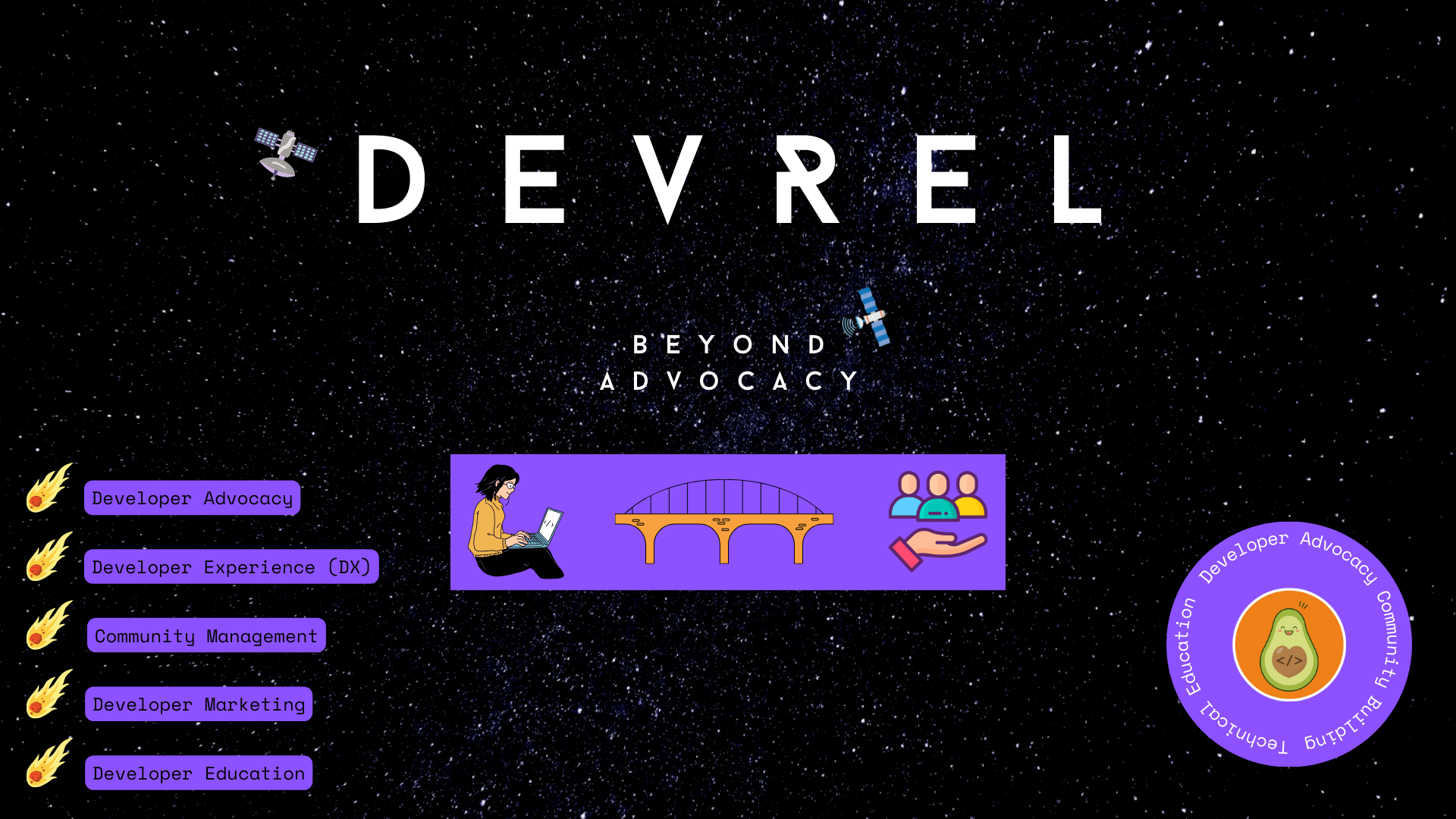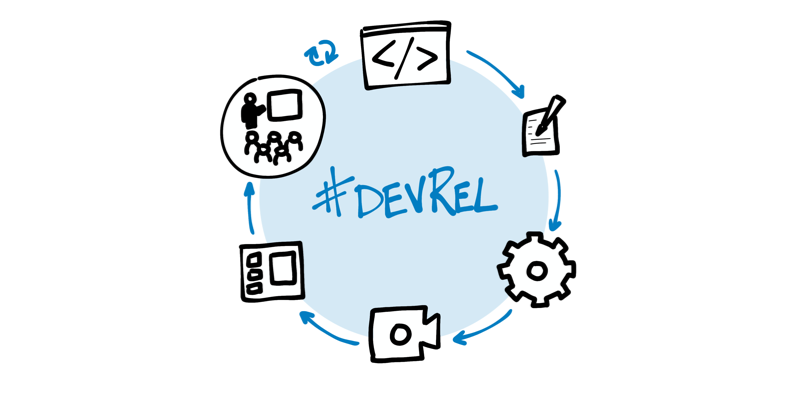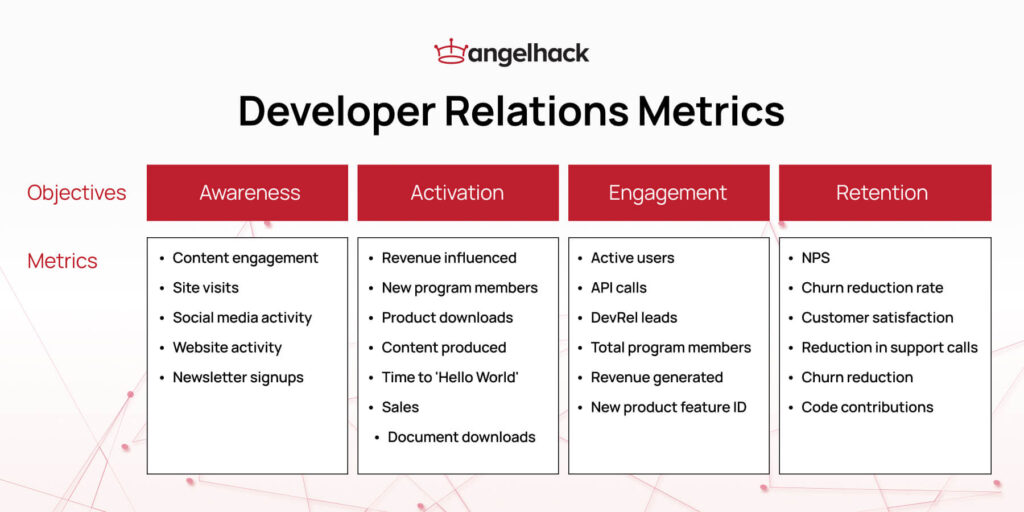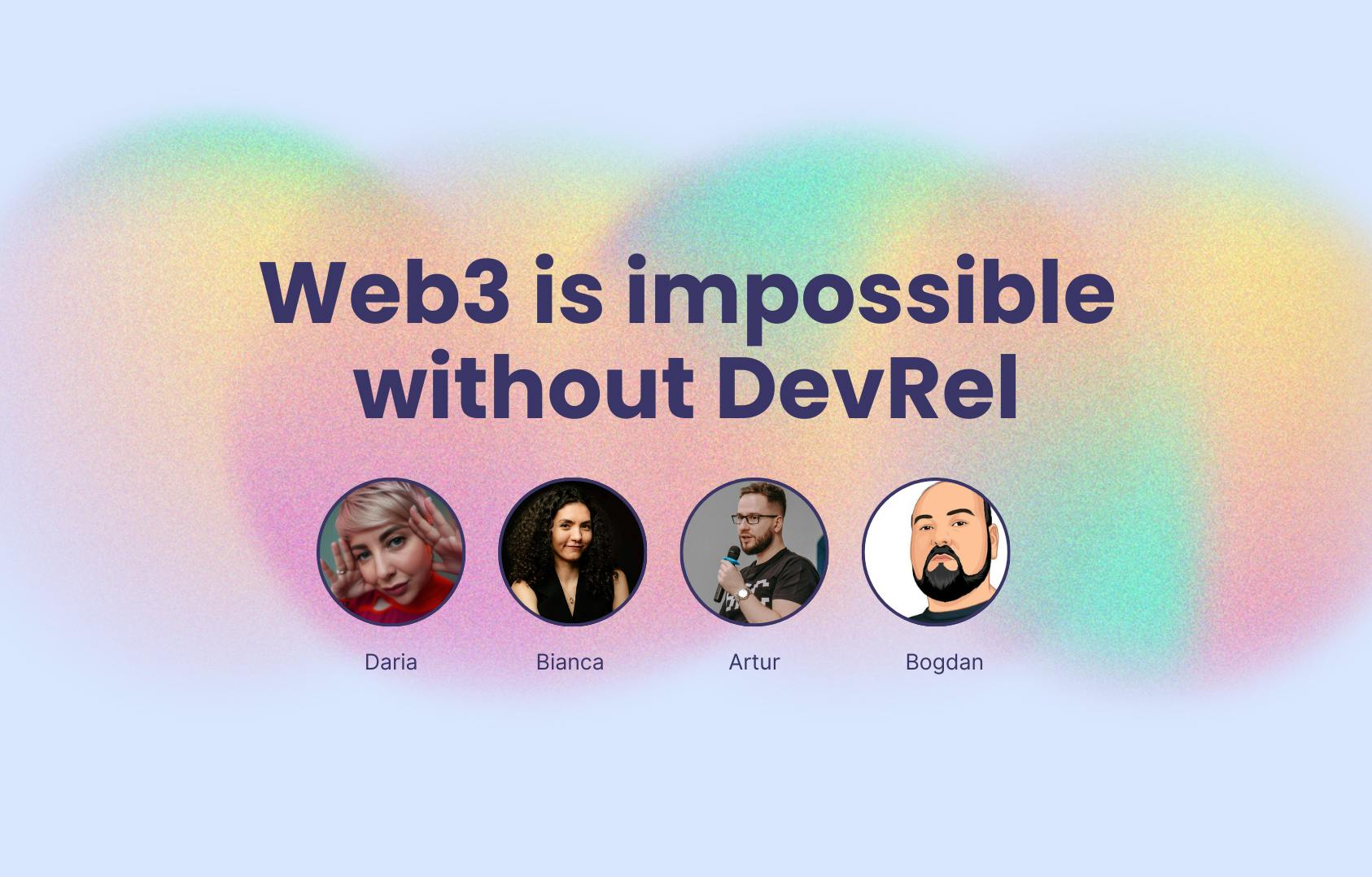DevRel: Beyond Advocacy - Bridging Tech, Community, and Innovation
 Pinku Agrawal
Pinku Agrawal
“DevRel is in a unique spot to provide missing pieces of information and points of view regarding developers to other teams. Likewise, DevRel is poised to benefit fron the mature tooling and deep capibilities that other teams can offer” - Josh Dzielak, Orbit co-founder & CTO
So What exactly is Devrel, You may have seen some incredible DevRel professionals representing their organizations at hackathons, managing launch events, or hosting workshops. But DevRel goes far beyond just these activities—it plays a deeper role in shaping developer engagement and product adoption. In this article, we’ll dive into what DevRel is, why it’s essential for an organization’s growth, its key components, and what DevRels actually do.

What is DevRel?
Developer Relations (DevRel) is the bridge between companies and developers. It’s a mix of advocacy, community engagement, and education, ensuring that developers not only use a product but love and trust it. Unlike traditional marketing, DevRel is about relationships, fostering open communication, and empowering developers with the right tools and knowledge.
Why Does DevRel Matter in Today’s Tech Ecosystem?
In a world driven by APIs, open-source projects, and developer-first companies, DevRel is no longer optional—it’s essential. Here’s why:
Developers influence product decisions – Companies need to listen to them.
Community-driven growth – Developers don’t just buy; they adopt and advocate.
Education is key – Good documentation, workshops, and engagement drive product success.
Companies that invest in DevRel see better adoption, more organic growth, and stronger developer loyalty. It’s not just about engagement—it’s about impact.
My Personal Journey in DevRel
I started working with communities in my junior year of college, as there wasn’t much of an environment for programming. I joined a lot of great communities and learned a lot from them. After all that, it was my turn to give back to the community, so I founded my own community in college. For my efforts, I became a GitHub Campus Expert. After that, I mentored two community leaders in their Campus Expert journey.
Later, I worked as an Associate Developer Advocate at Central DAO, a Web3 community, where I led their management team for the hackathon, managed their Discord server, set up the entire hackathon process, and wrote documentation. I also initiated the newsletter for Central DAO.
After that, I primarily focused on my Electronics degree and core Electronics and Computer Science. Finally, I was selected for the DX Mentorship, and I’m hoping to continue my DevRel journey in a magical way—potentially at Qiskit, which focuses on Quantum Computing, or at a company working in modern tech.
The Three Pillars of DevRel
At its core, Developer Relations (DevRel) stands on three foundational pillars: Developer Advocacy, Community Building, and Technical Education. These pillars work together to bridge the gap between developers and companies, ensuring both sides benefit from meaningful engagement.
Developer Advocacy: Bridging the gap between developers and companies
Developer Advocacy is about being the voice of developers inside a company and representing the company to the developer community. It’s a two-way street—helping developers understand the product while also ensuring that their feedback influences the product’s growth.
Key Responsibilities:
Engaging with developers to understand their challenges.
Providing actionable feedback to internal product teams.
Creating content (blogs, talks, tutorials) that makes technology more accessible.
Example: A DevRel professional might notice developers struggling with API documentation and push for improvements internally, making the product more user-friendly.
Community Building: Creating a space where developers grow together.
A strong developer community is what sustains a product in the long run. DevRel professionals foster these communities, ensuring developers feel valued, heard, and supported. It’s about creating an environment where developers can collaborate, share knowledge, and grow together.
Key Responsibilities:
Organizing meetups, hackathons, and forums.
Encouraging knowledge sharing through open-source contributions.
Building relationships with key influencers and contributors.
Example: A well-maintained Discord or Slack community where developers discuss issues, share projects, and receive quick support can turn casual users into long-term advocates.
Technical Education: Empowering developers through knowledge sharing.
A core part of DevRel is making technology more accessible through education. Whether through documentation, workshops, or online courses, technical education helps developers adopt and use tools effectively.
Key Responsibilities:
Writing clear and concise documentation.
Hosting webinars and workshops on best practices.
Creating hands-on tutorials and sample projects.
Examples: A DevRel engineer might create an interactive coding tutorial that walks developers through integrating an API, making the learning process smoother and more engaging.

DevRel in Action: More than Just Evangelism and Code
DevRel is often mistaken for just writing technical blogs or speaking at conferences, but its impact extends far beyond. It’s about creating meaningful experiences, fostering communities, and ensuring developers have everything they need to succeed. DevRel is a blend of advocacy, education, marketing, and product experience—all working together to bridge the gap between developers and technology.

Main Forms of DevRel
Developer Advocacy: The Voice of Developers
Developer Advocates serve as the bridge between developers and a company’s product. Their job is to listen, engage, and ensure that developers' needs are heard within the company. They create content, speak at events, contribute to open source, and provide direct feedback to product teams. The best advocates are not just promoting a product—they genuinely help developers solve real-world problems.
Developer Experience (DX): Making Development Effortless
A great product isn’t enough—it must be easy and enjoyable to use. DX professionals focus on improving the end-to-end experience for developers, from documentation and SDKs to onboarding flows and API usability. They work closely with engineering teams to identify friction points and refine the developer journey. When DX is done right, developers can focus on building, not troubleshooting.
Developer Community Management: Building and Nurturing Connections
Strong communities drive innovation. Developer Community Managers cultivate spaces—whether online or offline—where developers can collaborate, share knowledge, and grow together. They manage forums, organize events, and encourage contributions to open-source projects. The key is to create a sense of belonging and empowerment so developers feel invested in the ecosystem.
Developer Marketing: Communicating with Developers, Not at Them
Unlike traditional marketing, Developer Marketing isn’t about flashy ads—it’s about storytelling and education. It involves crafting technical content, case studies, and product updates in a way that resonates with developers. The goal is to ensure that developers understand the value of a product and can easily see how it fits into their workflows. Authenticity is key—developers can quickly spot insincerity.
Ecosystem & Integrations: Expanding Possibilities
A product is only as powerful as its integrations. DevRel professionals working on ecosystem growth focus on enabling developers to extend the product's capabilities. They collaborate with third-party developers, build APIs, create plugins, and ensure seamless integrations with other tools. A strong ecosystem makes a product indispensable.
Developer Education: Empowering Through Knowledge
Developers thrive on learning. Developer Educators create resources—tutorials, workshops, courses, and hands-on demos—to help developers upskill and build confidence with new tools. Whether through video content, interactive documentation, or in-person training, education in DevRel ensures that knowledge is accessible and practical.
Additional Aspects of DevRel
Open Source: Contributing to and supporting open-source projects fosters trust, adoption, and collaboration within the developer community. It’s about transparency and community-driven innovation.
Build in Public: Sharing progress, challenges, and insights openly helps engage developers and create authentic connections. It builds credibility while inviting feedback and contributions.
Internal DevRel: Advocacy isn't just external—internal DevRel ensures that engineering, marketing, and product teams align with developer needs, improving DX from within.
The Challenges of DevRel
There could be various challenges that can arise while implementing Devrel in an organization Balancing technical expertise, community engagement, and business impact can be difficult. Here are some of the key challenges DevRel professionals face:
"When GitHub first started building its community, it wasn’t just about getting users—it was about fostering a culture of contribution. But they faced a major challenge: How do you ensure long-term engagement? Their solution was to empower developers with better documentation, open-source initiatives, and active community involvement."
Here is the General Conversation between two DevRels that demonstrates the challenges that could arise in the DevRel.
DevRel 1 - “I just gave a talk at a conference, and it went well, but now I’m unsure how to track its impact. How do you measure success in this role?”
DevRel 2 - "Tell me about it! My team keeps asking for KPIs, but how do you measure the impact of a great talk or a strong community?"
Experienced DevRel - “That’s one of the toughest parts. Engagement is hard to quantify. Some companies track blog views, GitHub stars, or Discord activity, but real impact takes time to show.”
DevRel 1 - “Also, I feel like I’m constantly juggling technical work and community engagement. How do you balance it all?”
DevRel 2 - "And don’t even get me started on burnout. Between conferences, social media, and content creation, I barely get time to recharge. And we have to keep up with new tech trends too. It's exhausting!""
Experienced DevRel - “Honestly? It’s tough. If you’re not careful, burnout is real. You have to set boundaries.”

So from the above conversation, we get to know about the following challenges and there exist potential solutions for that :
Challenge: Measuring Success
Solution: Focus on engagement metrics like documentation contributions, API adoption, and community activity rather than just direct revenue.
Challenge: Balancing Advocacy and Business Needs
Solution: Be the bridge—translate developer concerns into actionable feedback for internal teams and vice versa.
The Future of DevRel
As technology accelerates, the role of DevRel is also evolving. No longer confined to just advocacy or community engagement, DevRel is becoming an integral part of product development, business strategy, and technological adoption.
Earlier DevRel was confined to a few organizations that were of large capacities but with the technological shift, even startups are adapting the DevRel in their organization. Here are the things that can happen in the future in the area of DevRel due to rising shifts :
Expanding to Emerging Technologies - With fields like Web3, Quantum Computing, and AI evolving rapidly, DevRel will play a crucial role in demystifying these technologies, creating accessible learning paths, and fostering early adoption.
The Rise of Micro-Communities - While large-scale developer communities will always exist, the trend is shifting toward niche, interest-based micro-communities. DevRel will need to adapt by fostering highly engaged, smaller groups where developers can share specialized knowledge and collaborate more effectively.
DevRel as a Business Driver - Companies are beginning to recognize DevRel’s impact beyond just advocacy—driving product adoption, influencing roadmaps, and even contributing to revenue generation. Future DevRel roles will be more aligned with business goals while maintaining their developer-first philosophy.
AI and Automation in DevRel - AI-driven tools will enhance developer support, automate documentation, and provide personalized learning experiences. Chatbots and AI-powered assistants could handle common developer queries, allowing DevRel professionals to focus on deeper engagement and problem-solving.

Recommended Learning
If you want to learn the ins and outs of DevRel and get in the DevRel field, these resources can certainly help you. Check these resources :
Developer Relations (DevRel) Jobs: The Complete Guide by Jono Bacon: https://www.youtube.com/watch?v=ZsCFGiQKb5Q
Developer Relations - The Book. How To Build And Grow A Successful Developer Program : https://www.devrel.agency/book
DevRel Resources By Dx-Mentorship: https://github.com/Dxmentorship/DevRel-Resources
Awesome Devrel : https://github.com/devrelcollective/awesome-devrel
DevRel Collective : https://devrelcollective.fun/
DevRel Resources : https://devrelresourc.es/#
Conclusions
Developer Relations is more than just advocacy—it's about fostering a culture of learning, collaboration, and innovation. At its core, DevRel thrives on building meaningful connections, not just between developers and products, but between ideas, communities, and the future of technology itself.
As technology continues to evolve, the role of DevRel will only become more critical. Whether it's empowering developers with knowledge, shaping communities, or driving the adoption of groundbreaking technologies, DevRel sits at the intersection of impact and influence.
So what I Believe is that It’s not just about amplifying a product—it’s about enabling developers to build, grow, and solve real-world problems.
Subscribe to my newsletter
Read articles from Pinku Agrawal directly inside your inbox. Subscribe to the newsletter, and don't miss out.
Written by

